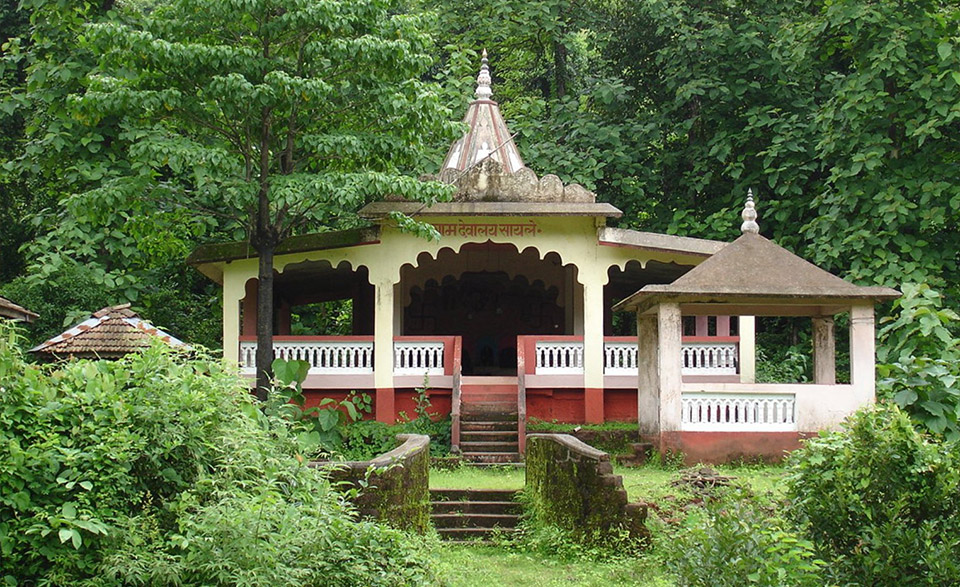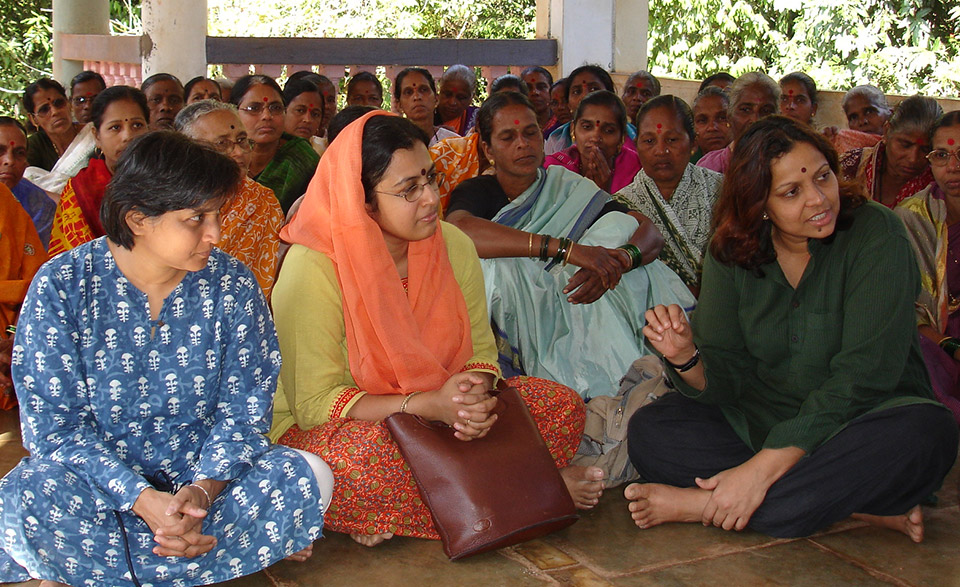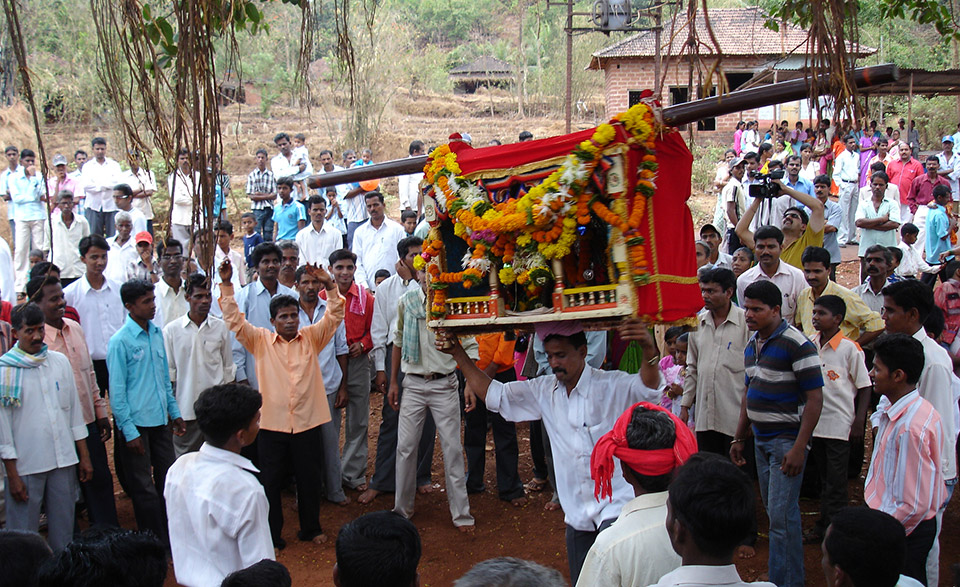Паўночна-Заходняй Гаты ў Індыі ў штаце Махараштра з'яўляецца экалагічна галіне фарміравання глабальнай гарачай кропкі біяразнастайнасці. Высокае біяразнастайнасць рэгіёну дапаўняецца высокім разнастайнасцю мясцовых традыцый у рэгіёне. Амаль кожная вёска ў Sahaydri-Konkan вобласць мае па крайняй меры адну святую гай з паверхні ў межах ад некалькіх да сотняў гектараў. Святыя гаі, якія захаваліся на працягу многіх сотняў гадоў, і сёння дзейнічаюць як рэзервуары біяразнастайнасці ўкрывальніцтва многіх відаў раслін і жывёл, як выпраўленая сеткі адносна некранутай дзікай прыроды.
Пад пагрозай.
Пагрозы
Пагрозы святыя гаі спыніць асноўным з аккультурации і глабалізацыя. Малы святыя гаі часта разглядаюцца як невялікія нязначна ўчасткі лесу, якія перашкаджаюць развіццю працы. Многія святыя гаі былі знішчаны, і толькі тэхнагенныя храмы былі захаваны. Прыклады прычын, чаму гэтыя гаі былі выдаленыя з'яўляюцца замахам, будаўніцтва дарог, пашу, будаўніцтва плацін і каналаў і урбанізацыі. Рашэнне змяніць або выдаліць пэўныя гаі часта прыязджаюць з навакольных вёсак, дзе павялічылася заходніх уплываў прывесці да паслаблення рэлігійных перакананняў, якая распаўсюджваецца па ўсім рэгіёне.
Зрок
Гэты рэгіён можа атрымаць выгаду ад адпаведнай формы сумеснага кіравання святых гаях, мясцовымі захавальнікамі, а таксама іншых рэгіянальных зацікаўленых бакоў. Найбольш перспектыўным спосабам дасягнення гэтага з'яўляецца аднаўленне культурных нормаў і пашырэнне правоў і магчымасцяў захавальнікаў, мясцовага насельніцтва і традыцыйных органаў кіравання. Доўгатэрміновая праца вельмі важная для стварэння цвёрдага альянсаў паміж рознымі бакамі. Бесперапынная фінансавая падтрымка неабходная разам з моцнымі бягучае садзейнічанне ў ажыццяўленні працэсаў. Гэта могуць быць эфектыўным сродкам для перадачы святых гаяў і іх биокультурных значэнне для будучых пакаленняў.
Дзеянне
AERF спецыяльна працаваў над павелічэннем і тыражаваннем доўгатэрміновага кіравання святымі гаямі з удзелам суполак у розных вёсках. Яны паспрабавалі адрадзіць традыцыйныя падыходы да прыроды шляхам павышэння дасведчанасці мясцовых жыхароў і распрацоўкі стымулаў для кіравання. Яны аб'ядналі зацікаўленых бакоў як на блокавым, так і на раённым узроўнях.
Палітыкі і правы
Права ўласнасці на гаі ў цяперашні час належыць дэпартаменту дзяржаўных даходаў.
Ахова святых гаёў у рэгіёне не можа выкарыстоўваць тую ж прававую сістэму, што і для аховы лясоў, таму што правілы кіравання розныя. У некаторых святых гаях, лімітаваная норма здабычы ўстанаўліваецца на асобныя недраўняныя лесапрадукцыі. Правілы і парадкі, вызначаныя продкамі, не запісваюцца, і часам скручваюцца дзеля кароткатэрміновых выгод.
Захавальнікі
Традыцыйныя метады захавання, такія як святыя лясы, з'яўляюцца важным кампанентам ландшафту ў трох раёнах паўночна-заходняга штата Махараштра.. Гаі ў асноўным належаць вяскоўцам, якія ўсё яшчэ могуць выжыць на сваіх землях без неабходнасці развіваць свае святыя гаі. Кіраванне свяшчэнным гаем, уключаючы рэлігійныя функцыі і ахову, кантралюе і кантралюе група вясковых старэйшын. Культурнае значэнне высокае, і большасць супольных святаў адзначаецца ў храме, размешчаным у святым гаі. Некаторыя з гаяў таксама функцыянуюць як магільнікі і крэматорыі, а некаторыя з'яўляюцца месцам знаходжання прывідаў і бостваў. Акрамя вады, людзі не выкарыстоўваюць ніякіх рэсурсаў з гэтых гаяў, як гэта робіцца ў іншых рэгіёнах Індыі.
Кааліцыя
Фонд прыкладных экалагічных даследаванняў (АЭРФ) працуе над захаваннем святых гаяў у Паўночна-Заходніх Гатах больш 15 гадоў. У блоку Сангамешвар, AERF адрадзіў традыцыю святых гаёў і прыцягнуў мясцовае насельніцтва да планавання, а таксама рэалізацыі для доўгатэрміновага захавання святых гаёў.
Захаванне інструменты
Сумеснае кіраванне - адна з важных адпраўных кропак, палягчэнне ўзаемаразумення паміж бакамі. Былі арганізаваны пасяджэнні зацікаўленых бакоў, выклікаючы ў розных груп энтузіязм і цікаўнасць да святых гаяў. Сродкі масавай інфармацыі адыгрываюць важную ролю ў фарміраванні кансенсусу і інфармаванасці аб праблемах навакольнага асяроддзя, але яны маглі б абмяркоўваць больш тэм аб святых гаях. AERF стымулюе мясцовыя супольнасці адраджаць свае старажытныя традыцыі праз удзел. Яны выкарыстоўвалі мясцовыя традыцыйныя міфы, танец, песень і абрадаў для выпрацоўкі агульнага разумення касмабачання вяскоўцаў, аднаўляючы яго там, дзе неабходна, каб падтрымаць утрыманне святых гаяў. Дадаткова, яны робяць інвентарызацыю біяразнастайнасці, каб выявіць сур'ёзнасць сітуацыі.
«Такія рашэнні, як патрабаванне дазволу на выкарыстанне рэсурсаў святых гаёў для дабрабыту вёскі, звычайна прымаюцца ў храме».
- Арчана Годбол, Дырэктар Фонду прыкладных экалагічных даследаванняў.
- Годбол, Сарнайк, Хутка, (2010) Культуралагічнае захаванне святых гаёў: Вопыт паўночна-заходніх Гат, Індыя, У Verschuuren, Дзікі, Макнамі і Овьедо, Святых прыродных аб'ектаў: Захаванне прыроды і культуры, Зямля сканавання, Лондан.
- Фонд прыкладных экалагічных даследаванняў у Пуне, Індыя: www.aerfindia.org








